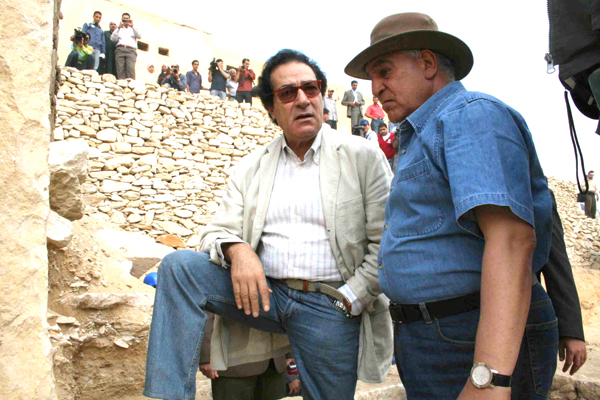|
Queen’s Pyramid Discovered at Saqqara
Dr. Zahi Hawass, Secretary General of the Supreme Council of Antiquities, announced today that he and his team have discovered the pyramid of a 6th Dynasty queen at Saqqara. Minister of Culture Farouk Hosni was present for the announcement, which took place today at the site of the discovery. Dr. Hawass said that the pyramid, which dates to about 4,300 years ago, is 5 meters in height, although it originally reached about 14 meters. The base is square, each side having a length of 22 meters. The sides of the pyramid sloped at an angle of 51 degrees, and the entire monument was originally covered in a casing of fine white limestone from Tura. Dr. Hawass believes that the pyramid, the architecture of which is characteristic of Dynasties 5 and 6, belonged to a queen named Sesheshet. Sesheshet was the mother of King Teti, the first king of Dynasty 6. We are familiar with this queen from a mention of her in a medical papyrus containing a recipe, supposedly created at her request, for a preparation to strengthen the hair. In the area surrounding the pyramid, Hawass’s team has found funerary figurines that date to the 3rd Intermediate Period (818-712 BC), along with a New Kingdom chapel (ca. 1550 BC) decorated with a scene of the deceased offering to Osiris. Other finds from the area include a group of Late Period (399-343 BC) coffins, a wooden statue of the god Anubis, amulets, and a symbolic vessel in the shape of a cartouche, which still contained the remains of a green substance. These finds demonstrate that the entire area of the Old Kingdom Teti cemetery was re-used from the New Kingdom (1550 – 1295 BC) through the Roman Period (30 BC – 364 AD). Near the newly discovered pyramid, Hawass and his Egyptian team had previously re-discovered the pyramid of Queen Khuit, the wife of King Teti. Scholars had long believed that Khuit was a secondary wife, but Hawass’s important work proved that her pyramid was built before that of Iput I, previously believed to have been Teti’s chief queen. The fact that her pyramid was built before Iput’s, however, tells us that Khuit was in fact the primary royal wife. Previous work at this site, where Hawass has been excavating since he served as Director of Giza and Saqqara, has also revealed the funerary temple of Khuit, offering much new information about the decorative programs of queens’ monuments of the period. Hawass stated that the discovery of the pyramid of Sesheshet will further enrich our understanding of the pyramids of Dynasty 6. (photos by Mohamed Magahed)
|


